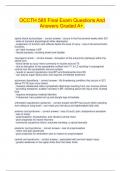OCCTH 585 Final Exam Questions And
Answers Graded A+.
spinal shock acute phase - correct answer.- occurs in the first several weeks after SCI
- state of transient physiological reflex depression
- suspension of function and reflexes below the level of injury - loss of all sensorimotor
functions
- an initial increase in BP
- flaccid paralysis, including bowel and bladder
neurogenic shock - correct answer.- disruption of the autonomic pathways within the
spinal cord
- shock tends to occur more commonly in injuries around T6
- due to disruption of the sympathetic outflow from T1 to L2 resulting in supraspinal
control over the sympathetic nervous system
- results in severe hypotension (low BP) and bradycardia (low HR)
- can lead to organ dysfunction and requires immediate treatment
autonomic dysreflexia - correct answer.- life threatening condition that occurs in SCI
above T5-T6 (can occur lower)
- massive imbalanced reflex sympathetic discharge resulting from non-noxious stimuli
- pounding headache, sudden increase in BP, sweating above the injury level, flushed
face
- requires emergency medical attention
- if observed, have patient sit-up and dangle legs at bedside
orthostatic hypotension (postural) - correct answer.low BP that occurs when standing
from sitting or lying down - can make you feel dizzy and lightheaded (falls risk)
anterior cord syndrome - correct answer.- loss of touch, pain, temperature sensation
- loss of motor
- proprioception, kinaesthesia, and vibratory sense intact
- poor prognosis for neural recovery
- commonly caused by infarct, traumatic bending, or spinal stenosis
posterior cord syndrome - correct answer.- loss of proprioception
- motor and pain preserved
- poor prognosis for ambulation due to impact on proprioception
central cord syndrome - correct answer.- associated with cervical region injury
- greater weakness in the upper limbs than the lower limbs
,- pain, temperature sensation preserved
- usually due to hyperextension (whiplash in MVA)
- seen in older age
brown-sequard syndrome - correct answer.- hemi-section
- ipsilateral motor and proprioception loss (flaccid at level of injury; spasticity paralysis
below lesion)
- contralateral pain and temperature sensation loss
- favourable prognosis for ambulation, ADL independence, and bladder control
ASIA impairment scale - correct answer.A - complete, no motor or sensory
B - incomplete, sensory preserved (no motor)
C - incomplete, motor preserved (>50% muscle grade less than 3)
D - incomplete, motor preserved (>50% muscle grade 3+)
E - normal
C4 - correct answer.- some resp issues (unable to cough), not usually on vent
- have control of diaphragm, trapezius
- communication - computer, environmental control unit
- require transportation and access
- need 24 hour care
C5 - correct answer.- shoulder abduction, elbow flexion, supination
- eating - universal cuff, plate guard, cup holder, straw
- able to assist with upper extremity dressing and grooming
- independence with eating, drinking, face washing, tooth brushing, shaving, hair care,
with set-up and equipment
C7 - correct answer.- elbow extension, wrist flexion, shoulder abduction, elbow flexion,
supination
- manual wheelchair possible
- more ease with household transfers, wheelchair pushups, and pressure relief
- less adaptive equipment needed
- fatigue easily
T6 - correct answer.- finger flexors, abductors
- upper extremity control
- better rib, chest and trunk control as higher thoracic levels are innervated
- independent with ADL (with AT)
- minimal assistance - independent with bowel and bladder
- manual wheelchair
- transfer with transfer board
, - hand controls in car
T10 - correct answer.- paraplegic ambulation
- have capability walking
- added function with increased abdominal muscle control
- improved pulmonary and cough control
- increased ability to perform unsupported seating activities (ex. bending over to pick
something up off the floor)
right CVA - correct answer.- visual-spatial perceptual disorders (ex. neglect,
constructional apraxia)
- emotional disorders (impulsivity, liability, depression)
- communication - difficult using language effectively, taking turns in convo may be
impacted
- lack of insight into own deficits
- may be unaware of people or cars approaching from left
- stair climbing and independent sitting impacted
- may only attend to one side for dressing, grooming, eating
left CVA - correct answer.- aphasia (expressive is most common)
- apraxia (speech, gait, dressing)
- emotional disorders
- difficulty walking, dressing, communicating, transfering
- ADLs are impacted
MCA stroke - correct answer.- impacts sensory, motor and cognition
- expect more impact on arm, hand, face and speech
- contralateral hemisensory loss
- hemiplegia
- visual field deficits
- apraxia
- perseveration
- poor judgement
- emotional problems
- apathy
PCA stroke - correct answer.- perceptual deficits (alexia, anomia, visual agnosia,
prosopagnosia)
- memory impairment
- homonumous hemianopsia
ACA stroke - correct answer.- impacts motor and sensory - mainly legs, bowel, bladder
and shoulder
- behavioural disturbances if frontal lobe involvement
- apraxia
- contralateral hemisensory loss




